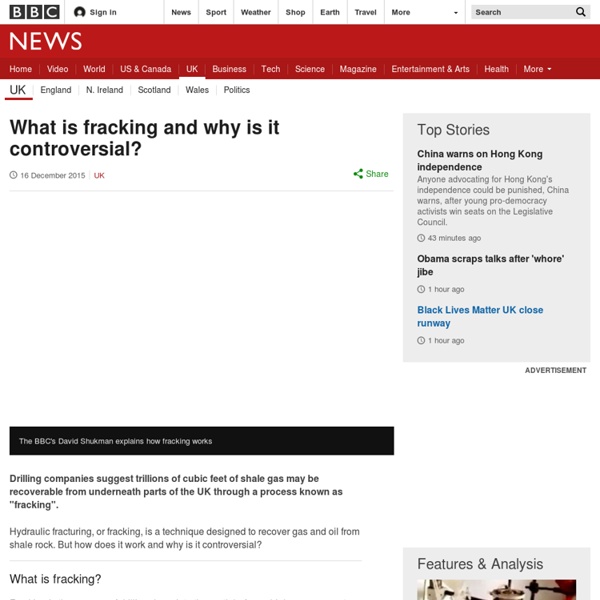Hydraulic fracturing
The first experimental use of hydraulic fracturing was in 1947, and the first commercially successful applications were in 1949. As of 2012, 2.5 million hydraulic fracturing jobs have been performed on oil and gas wells worldwide, more than one million of them in the United States.[4][5] Frac job in progress Geology[edit] Mechanics[edit] Fracturing in rocks at depth tends to be suppressed by the confining pressure, due to the immense load caused by the overlying rock strata and the cementation of the formation. Veins[edit] Dikes[edit] Low-level minor intrusions such as dikes propagate through the crust in the form of fluid-filled cracks, although in this case the fluid is magma. Non-hydraulic fracturing[edit] Fracturing as a method to stimulate shallow, hard rock oil wells dates back to the 1860s. Hydraulic fracturing in oil and gas wells[edit] The relationship between well performance and treatment pressures was studied by Floyd Farris of Stanolind Oil and Gas Corporation. Uses[edit]
Fracking's Latest Scandal? Earthquake Swarms
At exactly 10:53 p.m. on Saturday, November 5, 2011, Joe and Mary Reneau were in the bedroom of their whitewashed and brick-trimmed home, a two-story rambler Mary's dad custom-built 43 years ago. Their property encompasses 440 acres of rolling grasslands in Prague, Oklahoma (population 2,400), located 50 miles east of Oklahoma City. When I arrive at their ranch almost a year later on a bright fall morning, Joe is wearing a short-sleeve shirt and jeans held up by navy blue suspenders, and is wedged into a metal chair on his front stoop sipping black coffee from a heavy mug. His German shepherd, Shotzie, is curled at his feet. Joe greets me with a crushing handshake—he is 200 pounds, silver-haired and 6 feet tall, with thick forearms and meaty hands—and invites me inside. On that night in November, just as he and Mary were about to slip into bed, there was "a horrendous bang, like an airliner crashing in our backyard," Joe recalls. Joe and Mary Reneau Photographs by Ben Sklar
4 Scary New Finds About Fracking This Week
Photo Credit: Shutterstock.com/Steve Collender December 6, 2012 | Like this article? Join our email list: Stay up to date with the latest headlines via email. This article was published in partnership with GlobalPossibilities.org. Faculty and staff at the Community College of Philadelphia want their institution to “severe all ties to the Marcellus Shale Coalition and the gas fracking industry.” The pushback is a welcome development because it’s not often that fracking is followed by much good news. 1. By now you likely know that most states (and the federal government) don’t require companies that frack oil and gas wells to disclose the multitude of chemicals in the toxic slurry that gets pumped underground. The problem? Few people outside Nabors, the largest onshore drilling contractor by revenue, know exactly what’s in that blend. 2. “Williams said when he looked up to see what the commotion was, the truck's rear end was in the air,” the Intelligencer/Wheeling News-Register reported.
CONFIRMED - Link Between Fracking and Earthquakes
By. John C.K. Daly of Oilprice.com On 5 November 2011 an earthquake measuring 5.6 rattled Oklahoma and was felt as far away as Illinois. Until two years ago Oklahoma typically had about 50 earthquakes a year, but in 2010, 1,047 quakes shook the state. Why? In Lincoln County, where most of this past weekend’s seismic incidents were centered, there are 181 injection wells, according to Matt Skinner, an official from the Oklahoma Corporation Commission, the agency which oversees oil and gas production in the state. Cause and effect? The practice of injecting water into deep rock formations causes earthquakes, both the U.S. The U.S. natural gas industry pumps a mixture of water and assorted chemicals deep underground to shatter sediment layers containing natural gas, a process called hydraulic fracturing, known more informally as “fracking.” According to the U.S. Why was the process halted? According to the USGS website, under the undated heading, “Can we cause earthquakes?
Shale gas by country - Wikipedia
Shale gas is natural gas produced from shale, a type of sedimentary rock. Shale gas has become an increasingly important source of natural gas in the United States over the past decade, and interest has spread to potential gas shales in Canada, Europe, Asia, and Australia. One analyst expects shale gas to supply as much as half the natural gas production in North America by 2020.[1] In a 2013 report, the US Energy Information Administration estimated the quantity of technically recoverable shale gas for 41 countries.[2][3] North America leads the worldwide production of shale gas, with the US and Canada having significant levels.[4] Beyond the US and Canada, shale gas is so far produced at a commercial scale only in Argentina and China. While the shale gas potential of many nations seems promising, there are several obstacles spanning several economic, environmental, technical and social issues grouped in major categories such as access to resources, infrastructure and governance.[5]
Shale Gas in Europe Archives - Shale Gas : Shale Gas
Shale Gas and EU Energy Security 11 December 2014 The European Parliamentary Research Service’s report Shale Gas and EU Energy Security aims to advise MEPs of... Read more Shale gas in Europe position paper 13 November 2014 International Association of Oil & Gas Producers’s (IOGP) position paper on Shale gas in Europe suggests that... Reducing European Dependence on Russian Gas: Distinguishing natural gas security from geopolitics 27 October 2014 The Oxford Institute for Energy Studies has published “Reducing European Dependence on Russian Gas: Distinguishing natural gas... Midland Valley of Scotland Shale Study – British Geological Survey (June 2014) The British Geological Survey, commissioned by the Department of Energy and Climate Change, has studied the... European Energy Security Strategy – European Commission (May 2014) The European Energy Security Strategy together with an in-depth study of Member States’ energy dependence seeks to ensure that security...



